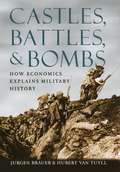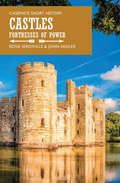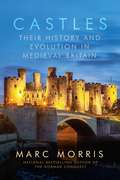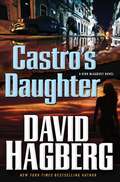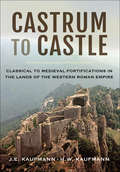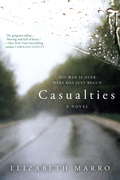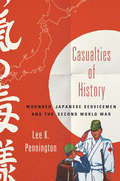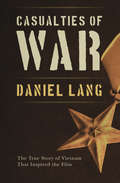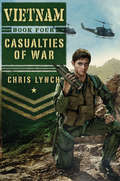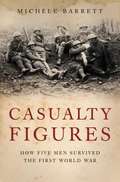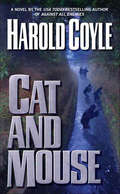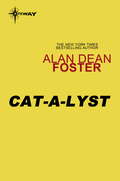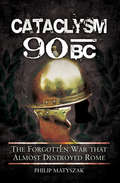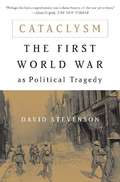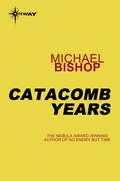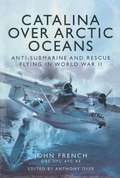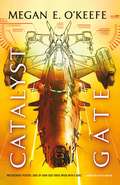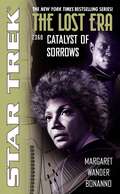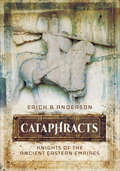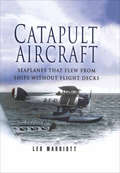- Table View
- List View
Castles, Battles, and Bombs: How Economics Explains Military History
by Jurgen Brauer Hubert Van TuyllCastles: Fortresses of Power (Casemate Short History)
by John Sadler Rosie SerdivilleThe authors of Knights: Chivalry and Violence let readers inside the walls of the Medieval period’s most iconic structure.In ancient and medieval times castles were the ultimate symbol of power, dominating their surroundings, and marking the landscape with their imposing size and impregnable designs. This concise and entertaining short history explores the life of the castle, one that often involved warfare and sieges. The castle was a first and foremost a fortress, the focus of numerous clashes which took place in the twelfth and thirteenth centuries. Castles became targets of sieges—such as that organized by Prince Louis of France against Dover castle in 1216—and were forced to adopt greater defensive measures. Also explored is how they evolved from motte-and-bailey to stone keep castles, in the face of newly developed siege machines and trebuchets. The trebuchet named Warwolf, which Edward I had assembled for his siege of Scotland’s Stirling Castle, reportedly took three months to construct and was almost four hundred feet tall on completion. With features such as “murder-holes” for throwing boiling oil at the attackers, the defenders in the castle fought back in earnest. Alongside such violence, the castle functioned as a residence for the nobles and their servants, often totaling several hundred in number. It was the location for extravagant banquets held in the great hall by the lord and lady, and the place where the lord carried out his administrative duties such as overseeing laws and collecting taxes.
Castles: Their History and Evolution in Medieval Britain
by Marc MorrisFrom the author of The Norman Conquest and A Great and Terrible King comes a sweeping and stunning history of the most magnificent castles in Britain. Beginning with their introduction in the eleventh century, and ending with their widespread abandonment in the seventeenth, Marc Morris explores many of the country’s most famous castles, as well as some spectacular lesser-known examples. At times this is an epic tale, driven by characters like William the Conqueror, King John and Edward I, full of sieges and conquest on an awesome scale. But it is also by turns an intimate story of less eminent individuals, whose adventures, struggles and ambitions were reflected in the fortified residences they constructed. Be it ever so grand or ever so humble, a castle was first and foremost a home. To understand castles—who built them, who lived in them, and why—is to understand the forces that shaped medieval Britain.
Casto (Gods of War #1)
by Xenia MelzerGods of War: Book IAll is fair in love and war. Renaldo has lived happily by that proverb his entire life. But he has finally met his match, and he's about to discover how unfair love and war can be. When demigod and warlord Lord Renaldo takes a beautiful stranger captive during an ambush, he is delighted to have found a distraction that will keep him entertained during the upcoming siege. Little does he know, Casto is keeping more than just one secret from him. Slowly, Renaldo gets sucked into a turbulent roller-coaster relationship with his mysterious prisoner, one that begins with hatred and soon spirals into a whirlwind of conflicting emotions. And when it seems that things can get no worse, an old enemy stirs right in the heart of his home. Determined to keep Casto by his side, Renaldo has to find a balance between the capricious young man and his own destiny as a ruler and god to his people.
Castro's Daughter (Kirk McGarvey Series #16)
by David HagbergCuban intelligence service colonel Maria Leon is called to the bedside of the dying Fidel Castro. Leon is Castro's illegitimate daughter, but this is the first time her father has acknowledged her. Castro makes Leon promise to contact the legendary former director of the CIA Kirk McGarvey and ask him to help her search for Cibola, the fabled Seven Cities of Gold. As the Cuban government unravels in the wake of Castro's death, Leon has to use every means at her disposal just to find the elusive McGarvey, while fending off men in her own Operations Division who want her job or her death. In desperation, Leon kidnaps McGarvey's closest friend, Otto Rencke, to force McGarvey's hand. Mac's meeting with Leon launches the most bizarre mission of his entire career, one that takes him from Cuba to Mexico City to. Spain and finally to an ancient site in New Mexico that the Spanish conquistadors called the Jornada del Muerto--the Journey of Death. The latest installment in David Hagberg's New York Times bestselling Kirk McGarvey series takes the former CIA director on another deadly international adventure.
Castro's Ploy: The 1980 Cuban Boatlift
by Alex LarzelereIn the summer of 1980, more than 125,000 Cubans abandoned their homes and possessions and emigrated to the United States. When what began as a stream of dissidents became a torrent of refugees, the United States was caught short. Cuban Premier Fidel Castro was able to use the 1980 exodus for his own political objectives and, in the process, overwhelmed US immigration capacity.In this definitive study of what happened during those six months of 1980, Captain Alex Larzelere (US Coast Guard, Retired) shows how Castro controlled the initiative, forcing the United States into a reactive position. Among the refugees he allowed to leave Cuba, Castro included significant numbers of criminals, spies, and political prisoners, thereby showing disregard for international rules regarding emigration. The Carter administration’s plan to deal with the crisis, as the author points out, came too late to be effective. Anticipating that the United States may face a similar mass influx, Larzelere argues for a new Migration Plan. He offers a plan with four major points: (1) rapid executive decision-making at levels lower than the White House; (2) constructive direction from Washington to Federal agencies on the scene; (3) a working immigration agreement with Cuba; and (4) a controlled flow of refugees.
Castrum to Castle: Classical to Medieval Fortifications in the Lands of the Western Roman Empire
by J.E. Kaufmann H.W. KaufmannFor over a thousand years, from the time of the Roman Empire to the classic period of castle-building in the twelfth and thirteenth centuries, fortified sites played a key role in European warfare. This highly illustrated history gives a fascinating insight into their design and development and into the centuries of violence and conflict they were part of.The study traces the evolution of fortifications starting with those of the Romans and their successors. Included are the defences erected to resist Islamic invasions and Viking raids and the castles that were built during outbreaks of warfare. As the authors demonstrate, castles and other fortifications were essential factors in military calculations and campaigns they were of direct strategic and tactical importance wherever there was an attempt to take or hold territory.The factors that influenced their location, layout and construction are analysed, as is the way in which they were adapted to meet the challenges of new tactics and weapons.
Casual Slaughters and Accidental Judgments: Canadian War Crimes Prosecutions 1944-1948
by Patrick BrodeWar crimes prosecutions create unique difficulties as civilian standards of law are applied to the extraordinary circumstances of war. Governments are often surprisingly hesitant to pursue war criminals. Patrick Brode has produced a fascinating study of such issues in Casual Slaughters and Accidental Judgements, a history of Canada's prosecution of war crimes committed during the Second World War. It is a history that includes personalities such as Lt. Col. Bruce Macdonald, whose persistence overcame Ottawa's reluctance to pursue the 'war crimes business,' and SS Brigadeführer Kurt Meyer, whose last-minute reprieve from death by firing squad followed a trial reminiscent of a Hollywood melodrama. Brode illustrates the difficulties of applying law to a recently defeated enemy when the emotions and politics of war distort any sense of impartial justice. The trials also reveal much about the legal and diplomatic views that prevailed at the end of the war and democratic Canada's willingness to overcome its colonial past to defend its own interests on the international stage.<P><P>The objectivity of the trials is still subject to question and they have been condemned by some as retaliatory. Brode clearly shows that Canada's war crimes trials of 1945 to 1948 were a part of a movement to apply humane standards of conduct to warfare. Recent events in places such as Vietnam, Bosnia, and Somalia show how pertinent these concerns remain.
Casualties
by Elizabeth MarroA heartbreaking and insightful debut novel about the wars we fight overseas, at home, and within our own hearts. Some come back whole. Some come back broken. Some just never come back... As an executive for one of the most successful military defense contractors in the country, Ruth Nolan should have been thrilled when her troubled son, Robbie, chose to join the marines. But she wasn't. She was terrified. So, when he returns home to San Diego after his second tour in Iraq, apparently unscathed, it feels like a chance to start over and make things right--until a scandal at work tears her away from their reunion. By the next morning, Robbie is gone. A note arrives for Ruth in the mail a few days later saying, "I'm sorry for everything. It's not your fault. I love you." Without a backward glance, Ruth packs up Robbie's ashes and drives east, heading away from her guilt and regret. But the closer she gets to the coast she was born on, the more evident it becomes that she won't outrun her demons--eventually, she'll have to face them and confront the painful truth about her past, her choices, the war, and her son.From the Trade Paperback edition.
Casualties of History: Wounded Japanese Servicemen and the Second World War (Studies of the Weatherhead East Asian Institute, Columbia University)
by Lee K. PenningtonThousands of wounded servicemen returned to Japan following the escalation of Japanese military aggression in China in July 1937. Tens of thousands would return home after Japan widened its war effort in 1939. In Casualties of History, Lee K. Pennington relates for the first time in English the experiences of Japanese wounded soldiers and disabled veterans of Japan's "long" Second World War (from 1937 to 1945). He maps the terrain of Japanese military medicine and social welfare practices and establishes the similarities and differences that existed between Japanese and Western physical, occupational, and spiritual rehabilitation programs for war-wounded servicemen, notably amputees. To exemplify the experience of these wounded soldiers, Pennington draws on the memoir of a Japanese soldier who describes in gripping detail his medical evacuation from a casualty clearing station on the front lines and his medical convalescence at a military hospital. Moving from the hospital to the home front, Pennington documents the prominent roles adopted by disabled veterans in mobilization campaigns designed to rally popular support for the war effort. Following Japan’s defeat in August 1945, U.S. Occupation forces dismantled the social welfare services designed specifically for disabled military personnel, which brought profound consequences for veterans and their dependents. Using a wide array of written and visual historical sources, Pennington tells a tale that until now has been neglected by English-language scholarship on Japanese society. He gives us a uniquely Japanese version of the all-too-familiar story of soldiers who return home to find their lives (and bodies) remade by combat.
Casualties of War
by Daniel LangThe searing account of a war crime and one soldier&’s heroic efforts to bring the perpetrators to justice First published in the New Yorker in 1969 and later adapted into an acclaimed film starring Michael J. Fox and Sean Penn, Casualties of War is the shocking true story of the abduction, rape, and murder of a young Vietnamese woman by US soldiers. Before setting out on a five-day reconnaissance mission in the Central Highlands of South Vietnam, Sergeant Tony Meserve told the four men under his command that their first objective would be to kidnap a girl and bring her along &“for the morale of the squad.&” At the end of the mission, Meserve said, they would kill their victim and dispose of the body to avoid prosecution for abduction and rape—capital crimes in the Uniform Code of Military Justice. Private First Class Sven Eriksson was the only member of the patrol who refused to participate in the atrocity. Haunted by his inability to save the young woman&’s life, he vowed to see Meserve and the others convicted of their crimes. Faced with the cynical indifference of his commanding officers and outright hostility from his fellow infantrymen, Eriksson had the tenacity to persevere. He went on to serve as the government&’s chief witness in four courts-martial related to the infamous Incident on Hill 192. A masterpiece of contemporary journalism, Casualties of War is a clear-eyed, powerfully affecting portrait of the horrors of warfare and the true meaning of courage.
Casualties of War: Casualties of War (Vietnam #4)
by Chris Lynch"The best Vietnam War novels yet for this age range." -- Kirkus ReviewsMorris, Rudi, Ivan, and Beck are best friends for life. So when one of the teens is drafted into the Vietnam War, the others sign up, too. Although they each serve in a different branch, they are fighting the war together -- and they promise to do all they can to come home together.Of the four, it's Beck that has the most to lose. He's the smart one of the bunch, and he could be -- SHOULD be -- going to college. His parents certainly think so. But he has a pact to honor, and so Beck enlists in the US Air Force.As their tours of duty near completion and the war itself spirals further out of control, the four best friends are at last on a collision course. Will they all survive long enough to be reunited?
Casualty Figures: How Five Men Survived the First World War
by Michèle BarrettIn this delicate look at history in microcosm, Barrett (literary and cultural theory, Queen Mary, University of London) follows the experience of five soldiers who survived World War I, two in the medical corps and three in the trenches. Their survival was debatable, though each man suffered from shell shock that affected his later life and damaged his relations with family and friends. Using private letters, diaries and military records Barrett paints a harrowing portrait of these men, what they survived and how they coped but never really recovered. This is a beautifully written psychological biography that, sadly, is all too timely. Annotation ©2009 Book News, Inc., Portland, OR (booknews.com)
Cat and Mouse
by Günter Grass Ralph ManheimThe setting is Danzig during World War II. The narrator recalls a boyhood scene in which a black cat pounces on his friend Mahlke's mouse - his prominent Adams apple. This incident sets off a wild series of events that ultimately leads to Mahlke becoming a national hero. The book describes Mahlke's experiences as a German schoolboy. He is an alarmingly eccentric individual with a physical deformity, a precocious virility, and an obdurate conscience. The story that Gunter Grass weaves about him and his friends Is hilarious, tragic... one of the unforgettable novels of the twentieth century.
Cat and Mouse: A Novel (Nathan Dixon #5)
by Harold CoyleNew York Times–bestselling author Harold Coyle's Cat and Mouse reveals the chaos of warfare as Islamic terrorists, lead by their most charismatic leader to date, form a powerful coalition in hopes of breaking America's will to continue the war on terror. In the War on Terror, it is often difficult to tell who the enemy is. Sometimes your fiercest opponent isn't an insurgent or a fanatic bent on making a statement in blood, but a chain of command that is pursuing goals and objectives that have nothing to do with your unit's stated mission. Nathan Dixon finds out just how true this is when a new battalion commander, Lieutenant Colonel Robert Delmont, convinces his superiors that he has an all but foolproof plan for defeating Islamic terrorists in the Philippines—a plan that will ensure Delmont's promotion to full colonel and beyond. But the 3rd Regiment of the 75th Ranger battalion is pitted against no fool. Determined to create a fundamental Islamic state in Southeast Asia, a charismatic terrorist by the name of Hamdani Summirat unites the various Islamic factions into a confederation. Their aim is to drag the United States into a protracted war of attrition that the Americans cannot win. Summirat's factions play out a deadly game of cat and mouse, drawing the American forces into ambushes and small, bloody encounters with a small but highly trained core of Islamic fighters. Lieutenant General Scott Dixon, Deputy Chief of Staff for Operations with the US Army--and Nathan's father—soon finds that these enemies are practically impossible to hunt down. They are killing American troops almost at will. He realizes quickly that if the mission continues, many more Americans will be wounded or killed-- perhaps even his own son. But his pleas to his Commander-in-Chief are practically ignored. This dual game of cat and mouse is played out both in the jungles of Mindanae and in the forward operations base. Nathan Dixon must deal with a battalion commander who is determined to see his plan through, regardless of the price Nathan and his company must pay, while Scott Dixon must deal with a chain of command that refuses to alter a plan of attack in the face of a losing effort.
Cat-A-Lyst
by Alan Dean FosterA GAME OF CAT...AND CAT? Movie star Jason Carter is on vacation in Peru. All he wants is a break, but what he finds is a lost civilization of extra-dimensional Incas bent on conquest of the entire world! Nor is Carter alone. His allies include a bloodthirsty Amazon, an archaeologist, a bank robber, three alien vegetables and a scoop-crazed gossip columnist - and not one of them knows what to do next. Only Carter's cat seems unruffled by the growing danger. In true feline fashion, she acts like she's in charge of the planet. Maybe she is.
Cataclysm 90 BC: The Forgotten War that Almost Destroyed Rome
by Philip MatyszakA dramatic account of a rebellion against the Roman republic—by a confederation of its Italian allies. We know of Rome&’s reputation for military success against foreign enemies. Yet at the start of the first century BC, Rome faced a hostile army less than a week&’s march from the capital. It is probable that only a swift surrender prevented the city from being attacked and sacked. Before that point, three Roman consuls had died in battle, and two Roman armies had been soundly defeated—not in some faraway field, but in the heartland of Italy. So who was this enemy that so comprehensively knocked Rome to its knees? What army could successfully challenge the legions which had been undefeated from Spain to the Euphrates? And why is that success almost unknown today? These questions are answered in this book, a military and political history of the Social War. It tells the story of the revolt of Rome&’s Italian allies (socii in Latin), who wanted citizenship—and whose warriors had all the advantages of the Roman army that they usually fought alongside. It came down to a clash of generals—with the Roman rivals Gaius Marius and Cornelius Sulla spending almost as much time in political intrigue as in combat with the enemy. With its interplay of such personalities as the young Cicero, Cato, and Pompey—and filled with high-stakes politics, full-scale warfare, assassination, personal sacrifice, and desperate measures such as raising an army of freed slaves—Cataclysm 90 BC provides not just a rich historical account but a taut, fast-paced tale.
Cataclysm: The First World War as Political Tragedy
by David StevensonDavid Stevenson’s widely acclaimed history of World War I changes forever our understanding of that pivotal conflict. Countering the commonplace assumption that politicians lost control of events, and that the war, once it began, quickly became an unstoppable machine, Stevenson contends that politicians deliberately took risks that led to war in July 1914. Far from being overwhelmed by the unprecedented scale and brutality of the bloodshed, political leaders on both sides remained very much in control of events throughout. According to Stevenson, the disturbing reality is that the course of the war was the result of conscious choices--including the continued acceptance of astronomical casualties. In fluid prose, Stevenson has written a definitive history of the man-made catastrophe that left lasting scars on the twentieth century. Cataclysm is a truly international history, incorporating new research on previously undisclosed records from governments in Europe and across the world. From the complex network of secret treaties and alliances that eventually drew all of Europe into the war, through the bloodbaths of Gallipoli and the Somme, to the arrival of American forces, and the massive political, economic, and cultural shifts the conflict left in its wake, Cataclysm is a major revision of World War I history.
Catacomb Years
by Michael BishopThe second book in the Urban Nucleus series, containing the following:Prelude: The Domes (1978)If a Flower Could Eclipse (1970)Interlude: The Testimony of Leland Turner (1979)Old Folks at Home (1978)Interlude: The City Takes Care of Its Own (1979)The Windows in Dante's Hell (1973)Interlude: Volplaning Heroes (1979)The Samurai and the Willows (1976)Interlude: First Councilor Lesser (1979)Allegiances (1975)Interlude: The Cradle Begins to Rock (1979)At the Dixie-Apple with the Shoofly-Pie Kid (1977)Interlude: The Fall of Saganella Lesser (1979)Death Rehearsals (1979)
Catalaunian Fields AD 451
by Peter Dennis Simon MacdowallThe battle of the Catalaunian Fields saw two massive, powerful Empires square up in a conflict that was to shape the course of Eurasian history forever. For despite the Roman victory, the Roman Empire would not survive more than fifteen years afterward, while the Huns, shattered and demoralized, would meet their downfall against a coalition of German tribes soon after. This book, using revealing bird's-eye views of the plains of Champagne and detailed illustrations of the opposing warriors in the midst of desperate combat, describes the fighting at Chalons and reveals the broader campaign of Hunnic incursion that led up to it. Drawing on the latest research, Simon MacDowall reveals the shocking intensity and appalling casualties of the battle, while assessing the wider significance and consequences of the campaign.
Catalina over Arctic Oceans: Anti-Submarine and Rescue Flying in World War II
by John FrenchJohn French first took up flying in 1937 with the University of London Air Squadron and in 1938 joined the Royal Air Force Volunteer Reserve. His early war years were spent instructing newly recruited RAF pilots on Airspeed Oxfords and Avro Ansons. When the end of this posting came through he was designated to 210 Squadron at Sullom Voe in the Shetlands to fly the Catalina flying boat. In November 1942 the squadron was ordered south to join 202 Squadron at Gibraltar.Here they flew sorties in support of the North African landings Operation Torch. These were lengthy flights out into the Atlantic approaches to Gibraltar or Eastwards into the Mediterranean. He flew fifteen sorties in this short period before returning to Pembroke Dock. He was then instructed to report to Felixstowe to collect Catalina IB FP 222 and to ferry it up to his new base Sullom Voe.From this northern base the flying boats flew thirty hour patrols out into the Northern Atlantic searching for enemy ships and U-boats. On 8 September he was ordered to execute an extended search of the Norwegian coast where it was thought that the Tirpitz and Scharnhorst were seeking shelter. Having unsuccessfully searched the entire coastline at low-level they finally touched down on the Kola Inlet after a flight of over twenty-two hours.As February 1944 came towards its end he was detailed to cover a Russian convoy, JW57, far up to the north of the Arctic Circle. Shortly before his ETA with the convoy they got a radar return. They dropped down below the cloud to find a rough angry sea and spotted the wake of a ship. However this was not a ship but a surfaced U-boat. As they flew into attack they met a hail of 37mm and machine-gun fire John dropped to attack level and came in from the stern dropping two depth charges. Thus came the demise of U-601.On 18 July 1944 a Liberator of 86 Squadron was seton fire during an attack on a U-boat and was forced toditch some 100 miles west of the Loften Islands. Eightmembers of the crew took to their dinghies. A Catalinawas despatched on a search and rescue mission thefollowing day but failed to find the victims. However on20 July they were resighted. A volunteer crew washastily formed and took off at 0130 on the 21st. Someexcellent navigation brought the survivors into view atETA. John decided to attempt a sea landing to effect therescue. He came in low, into wind and across the swellat 65 knots. His crew soon had the stranded airmanaboard, somewhat bedraggled after their sixty-two hourordeal. They landed back at Sullom at 1410.After the war John stayed in the RAF and spent much ofhis time behind the Iron Curtain.
Catalyst Gate (The Protectorate #3)
by Megan E. O'KeefeThe universe is under threat and an ancient alien intelligence threatens to bring humanity down unless Major Sanda Greeve and her crew can stop it in the final book of this explosive Philip K. Dick award nominated space opera.The code has been cracked. The secrets of the Casimir gates have been revealed. But humanity still isn't safe. The alien intelligence known as Rainier and her clones are still out there, hell-bent on its destruction. And only Sanda can stop them.With the universe's most powerful ship under her command and some of the most skilled hackers, fighters, and spies on her team, it will still take everything she has to find the key to taking down an immortal enemy with seemingly limitless bodies, resources, and power.
Catalyst of Sorrows: Lost Era 2360 (Star Trek: The Original Series #4)
by Margaret Wander BonannoA lethal Romulan-trained agent turns against her masters on a dangerous quest into the heart of enemy territory in this thrilling Star Trek novel. She was trained to be a killing machine. Abandoned as a child, without home or family, past or future, Zetha survived only by her own cunning in the back alleys of Romulus before being taken by the Tal Shiar and remade into one of its deadliest weapons. But Zetha is about to undertake a mission unlike any in her experience. The mysterious return of a virulent scourge thought to be long extinct threatens devastation on a scale almost too horrific to contemplate. Zetha&’s only hope of stopping it is across the Neutral Zone—among the enemies of Romulus. Now Admiral Uhura, centenarian chief of Starfleet Intelligence, must decide what to do with the knowledge Zetha has risked her life to bring to her. In order to stop the spread of the disease that is already ravaging the Romulan Empire, Uhura must assign a hand-picked team of Starfleet officers to covertly trace the contagion to its source and do whatever is necessary to contain it. But are they already too late?
Cataphracts: Knights of the Ancient Eastern Empires
by Erich B AndersonA deeply researched and page-turning history of armored cavalry in the ancient world from the Eurasian steppe tribes to the late Byzantine Empire. Cataphracts were the most heavily armored form of cavalry in the ancient civilizations of the East, with riders and horses both clad in heavy armor. Originating among the wealthiest nobles of various central Asian steppe tribes such as the Massagetae and Scythians, the traditions and strategies of these proud warriors were adopted and adapted by several major empires—the Achaemenid Persians, Seleucids, Sassanians, and eventually the Romans and their Byzantine successors—from c. 4000 BCE to 1200 CE. Usually armed with long lances, the cataphracts harnessed the mobility and sheer mass of their horses to the durability and solid fighting power of the spear-armed phalanx. Although very expensive to equip and maintain, they were a powerful force in battle and remained in use for many centuries. In this compelling historical survey, Erich B. Anderson assesses the development, equipment, tactics, and combat record of cataphracts and the similar clibinarii, showing also how enemies sought to counter them. This is a valuable study of one of the most interesting weapon systems of the ancient world. &“A valuable study of one of the most interesting troop types of the ancient world.&” —The Armourer &“The first comprehensive survey of heavy armored cavalry . . . that played a particularly important role in the military history of Late Antiquity . . . This is a good survey of the history of heavy cavalry in the ancient world, covering arms, equipment, organization, tactics, and battles.&” —The NYMAS Review
Catapult Aircraft: Seaplanes That Flew From Ships Without Flight Decks
by Leo MarriottA concise history of this specialty aircraft used during World Wars I and II. During World War I, the navies of the opposing forces discovered the value of aerial reconnaissance, and many experiments were made to allow larger warships to carry one or sometimes two aircraft aboard. In the early days these were float planes that were lowered by crane into the sea and then lifted back aboard upon their return. This was a lengthy affair and when a speedy departure was necessary, time was of the essence. A new system was devised so that a powerful catapult system and a short ramp could, with the added speed of the ship, get an aircraft airborne in a fraction of the time previously required. Thus was born a highly specialised type of aircraft. This book includes all the major designs that went to war in the First and Second World Wars and includes aircraft used by all the combatants. It looks at how the aircraft evolved and how the warships were modified to accommodate the aircraft and the catapult system. The use of these fixed-wing aircraft was abandoned when the invention of the helicopter was made in the early post-WWII years.
